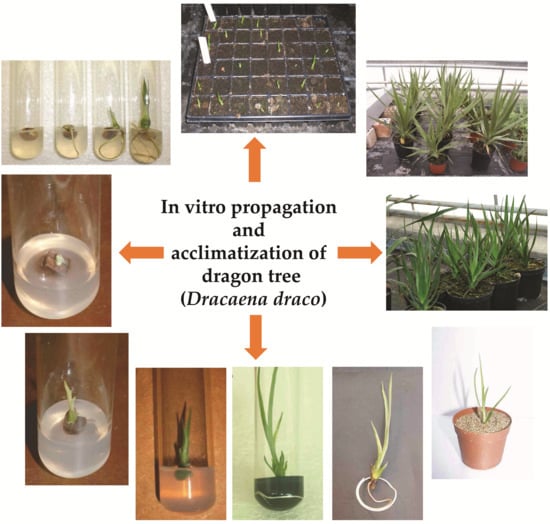In Vitro Propagation and Acclimatization of Dragon Tree (Dracaena draco)
Abstract
:1. Introduction
2. Materials and Methods
2.1. Plant Material
2.2. Dormant Bud Sterilization
2.3. Shoot Induction
2.4. Rooting of Developing Shoots
2.5. Acclimatization of Rooted D. Draco In Vitro Grown Plants
2.6. Statistical Analysis
3. Results and Discussion
3.1. Optimization of Dormant Bud Sterilization
3.2. Shoot Induction
3.3. Root Induction and Plant Maintenance
3.4. Acclimatization of Regenerated Plants
4. Conclusions
Author Contributions
Funding
Acknowledgments
Conflicts of Interest
References
- Krawczyszyn, J.; Krawczyszyn, T. Photomorphogenesis in Dracaena draco. Trees 2016, 30, 647–664. [Google Scholar] [CrossRef]
- Benabid, A.; Cuzin, F. Dragon tree (Dracaena draco subsp. ajgal Benabid et Cuzin) populations in Morocco: Taxonomical biogeographical and phytosociological values. C. R. Acad. Sci. 1997, 320, 267–277. [Google Scholar] [CrossRef]
- Chen, J.; Mc Connell, D.; Henny, R.; Everitt, K. Environmental Horticulture Department, Institute of Food and Agricultural Sciences, University of Florida. 1998. Available online: http://edis.ifas.ufl.edu (accessed on 20 June 2019).
- Monteiro, A.; Vasconcelos, T.; Tapadabertelli, A. Seed propagation of Dracaena draco. Garcia Orta Sér. Bot. 1999, 14, 187–189. [Google Scholar]
- Marrero, A. A new species of the wild dragon tree, Dracaena (Dracaenaceae) from Gran Canaria and its taxonomic and biogeographic implications. Bot. J. Linn. Soc. 1998, 128, 291–314. [Google Scholar]
- Jura-Morawiec, J.; Tulik, M. Dragon’s blood secretion and its ecological significance. Chemoecology 2016, 26, 101–105. [Google Scholar] [CrossRef]
- Miller, L.R.; Murashige, T. Tissue culture propagation of tropical foliage plants. In Vitro Cell. Dev. Biol. Anim. 1976, 12, 797–813. [Google Scholar] [CrossRef]
- Vinterhalter, D. In vitro Propagation of Green-Foliaged Dracaena-Fragrans Ker. Plant Cell Tissue Org. 1989, 17, 13–19. [Google Scholar]
- Vinterhalter, D.; Vinterhalter, B. Micropropagation of Dracaena Species. In Biotechnology in Agriculture and Forestry; Springer: Berlin/Heidelberg, Germay, 1997; Volume 40, pp. 131–146. [Google Scholar]
- Tian, L.; Tan, H.Y.; Zhang, L. Stem segment culture and tube propagation of Dracaena saneriana cv. virscens. Acta Hortic. Sin. 1999, 26, 133–134. [Google Scholar]
- Blanco, M.; Valverde, R.; Gomez, L. Micropropagation of Dracaena deremensis. Agron. Costarric. 2004, 28, 7–15. [Google Scholar]
- Murashige, T.; Skoog, F. A Revised Medium for Rapid Growth and Bio Assays with Tobacco Tissue Cultures. Physiol. Plant. 1962, 15, 473–497. [Google Scholar] [CrossRef]
- Liu, J.; Deng, M.; Henny, R.J.; Chen, J.; Xie, J. Regeneration of Dracaena surculosa through indirect shoot organogenesis. HortScience 2010, 45, 1250–1254. [Google Scholar] [CrossRef]
- Pérez, G.H.Y.; Claret, M.C.C.; Ada, M.M.M. In vitro morphogenesis of Dracena. Agron. Trop. 2006, 56, 577–583. [Google Scholar]
- Aslam, J.; Mujib, A.; Sharma, M.P. In vitro micropropagation of Dracaena sanderiana Sander ex Mast: An important indoor ornamental plant. Saudi J. Biol. Sci. 2013, 20, 63–68. [Google Scholar] [CrossRef]
- Junaid, A.; Mujib, A.; Sharma, M.P. Effect of growth regulators and ethylmethane sulphonate on growth, and chlorophyll, sugar and proline contents in Dracaena sanderiana cultured in vitro. Biol. Plant. 2008, 52, 569–572. [Google Scholar] [CrossRef]


| Sterilization Time (min) | Infection (%) | Healthy Buds (%) |
|---|---|---|
| 20 | 0 c z | 6.6 ± 11.5 cd |
| 10 | 0 c | 0 d |
| 5 | 0 c | 32.0 ± 3.6 ab |
| 2 | 0 c | 42.3 ± 2.5 a |
| 1 | 5.0 ± 3.6 b | 21 ± 3.6 bc |
| 0.5 | 67.2 ± 2.5 a | 0 d |
| Media | Hormonal Composition | Shooting % | Rooting % |
|---|---|---|---|
| S1 | 1 mg/L KIN, 1 mg/L NAA | 80.6 ± 1.2 a z | 0 c |
| S2 | 3 mg/L KIN, 1 mg/L IAA | 76.0 ± 4.6 a | 0 c |
| S3 | 1 mg/L BAP, 2 mg/L IBA | 24.6 ± 1.5 b | 0 c |
| S4 | 1 mg/L BAP 1 mg/L NAA | 0 c | 0 c |
| R1 | 0 mg/L IBA | 0 c | 0 c |
| R2 | 0.5 mg/L IBA | 0 c | 0 c |
| R3 | 1 mg/L IBA | 0 c | 51.0 ± 3.6 b |
| R4 | 2 mg/L IBA | 0 c | 66.2 ± 2.0 a |
© 2019 by the authors. Licensee MDPI, Basel, Switzerland. This article is an open access article distributed under the terms and conditions of the Creative Commons Attribution (CC BY) license (http://creativecommons.org/licenses/by/4.0/).
Share and Cite
Galus, A.; Chenari Bouket, A.; Belbahri, L. In Vitro Propagation and Acclimatization of Dragon Tree (Dracaena draco). Horticulturae 2019, 5, 64. https://doi.org/10.3390/horticulturae5030064
Galus A, Chenari Bouket A, Belbahri L. In Vitro Propagation and Acclimatization of Dragon Tree (Dracaena draco). Horticulturae. 2019; 5(3):64. https://doi.org/10.3390/horticulturae5030064
Chicago/Turabian StyleGalus, Alexis, Ali Chenari Bouket, and Lassaad Belbahri. 2019. "In Vitro Propagation and Acclimatization of Dragon Tree (Dracaena draco)" Horticulturae 5, no. 3: 64. https://doi.org/10.3390/horticulturae5030064







